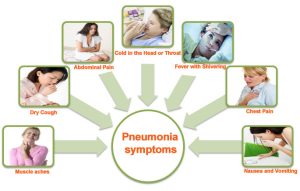- 29 February 2024
- 144
Simple Guide to Walking Pneumonia: What is it?

Introduction
Walking pneumonia, scientifically known as “atypical pneumonia,” is a milder form of pneumonia that typically doesn’t require bed rest or hospitalization. Despite its less severe nature, it can still be quite uncomfortable and may require medical attention to prevent complications and ensure a speedy recovery. In this comprehensive guide, we’ll delve into what walking pneumonia is, its symptoms, causes, diagnosis, treatment options, and preventive measures. Explore More About Health Problems And Their Solutions ( POTS Syndrome)
Understanding Walking Pneumonia
What Sets Walking Pneumonia Apart?
Walking pneumonia is different from typical pneumonia in several ways. Unlike traditional pneumonia, which is often caused by bacteria such as Streptococcus pneumoniae, walking pneumonia is commonly caused by bacteria like Mycoplasma pneumoniae or viruses like respiratory syncytial virus (RSV) or influenza (flu). This type of pneumonia tends to have milder symptoms, allowing individuals to continue their daily activities, hence the term “walking” pneumonia.
Symptoms of Walking Pneumonia
While symptoms can vary from person to person, common signs of walking pneumonia include:
- Persistent cough, which may produce mucus
- Mild fever or chills
- Sore throat
- Fatigue
- Headache
- Chest pain, particularly when coughing or breathing deeply
- Shortness of breath, especially during physical activity

Causes of Walking Pneumonia
Bacterial Causes
As mentioned earlier, Mycoplasma pneumoniae is one of the primary bacterial culprits behind walking pneumonia. This bacterium is highly contagious and can spread through respiratory droplets when an infected person coughs or sneezes. Other bacteria, such as Chlamydophila pneumoniae and Legionella pneumophila, can also cause atypical pneumonia.
Viral Causes
Viruses like RSV, influenza, adenovirus, and human parainfluenza virus can lead to walking pneumonia, particularly in children. These viruses are prevalent in crowded places like schools and daycare centers and can spread rapidly through close contact.
Diagnosing Walking Pneumonia
Medical Evaluation
If you suspect you have walking pneumonia based on your symptoms, it’s essential to consult a healthcare professional. Your doctor will perform a physical examination and may order additional tests to confirm the diagnosis.
Laboratory Tests
Laboratory tests, such as blood tests and sputum cultures, can help identify the specific pathogen causing your symptoms. A chest X-ray may also be recommended to assess the extent of lung involvement.

Treatment Options for Walking Pneumonia
Antibiotics
If your walking pneumonia is caused by bacteria, your doctor may prescribe antibiotics to help clear the infection. Commonly prescribed antibiotics include azithromycin, clarithromycin, or doxycycline. It’s crucial to complete the full course of antibiotics as prescribed, even if you start feeling better before finishing the medication.
Antiviral Medications
If a virus is responsible for your symptoms, antiviral medications may be recommended. However, unlike bacterial pneumonia, viral pneumonia typically resolves on its own with supportive care, such as rest, hydration, and over-the-counter pain relievers to alleviate discomfort.
Preventive Measures
Practice Good Hygiene
To reduce your risk of contracting walking pneumonia, practice good hygiene habits, such as washing your hands frequently with soap and water, especially after coughing or sneezing, and avoiding close contact with sick individuals.
Stay Home When Sick
If you develop symptoms of respiratory illness, including cough, fever, or sore throat, it’s essential to stay home from work, school, or other public places to prevent spreading the infection to others.
Vaccination
Getting vaccinated against influenza and pneumococcal pneumonia can help protect you from certain pathogens that can cause walking pneumonia. Talk to your healthcare provider about the recommended vaccines for your age and medical history.

Walking Pneumonia vs. Typical Pneumonia
| Aspect | Walking Pneumonia | Typical Pneumonia |
|---|---|---|
| Causative Agents | Mycoplasma pneumoniae, viruses (RSV, influenza) | Streptococcus pneumoniae, other bacteria |
| Symptom Severity | Mild | Severe |
| Bed Rest Needed | Usually not | Often required |
| Hospitalization | Rarely | Common |
| Treatment | Antibiotics (if bacterial), supportive care | Antibiotics, sometimes hospitalization |
Conclusion
While walking pneumonia is generally less severe than typical pneumonia, it’s essential to take it seriously and seek medical attention if you experience symptoms suggestive of this condition. By understanding the causes, symptoms, diagnosis, treatment options, and preventive measures outlined in this guide, you can better manage and potentially avoid walking pneumonia altogether.
Remember, early detection and appropriate treatment are key to a speedy recovery and preventing complications. If you have any concerns about your respiratory health, don’t hesitate to consult a healthcare professional for guidance and support.

